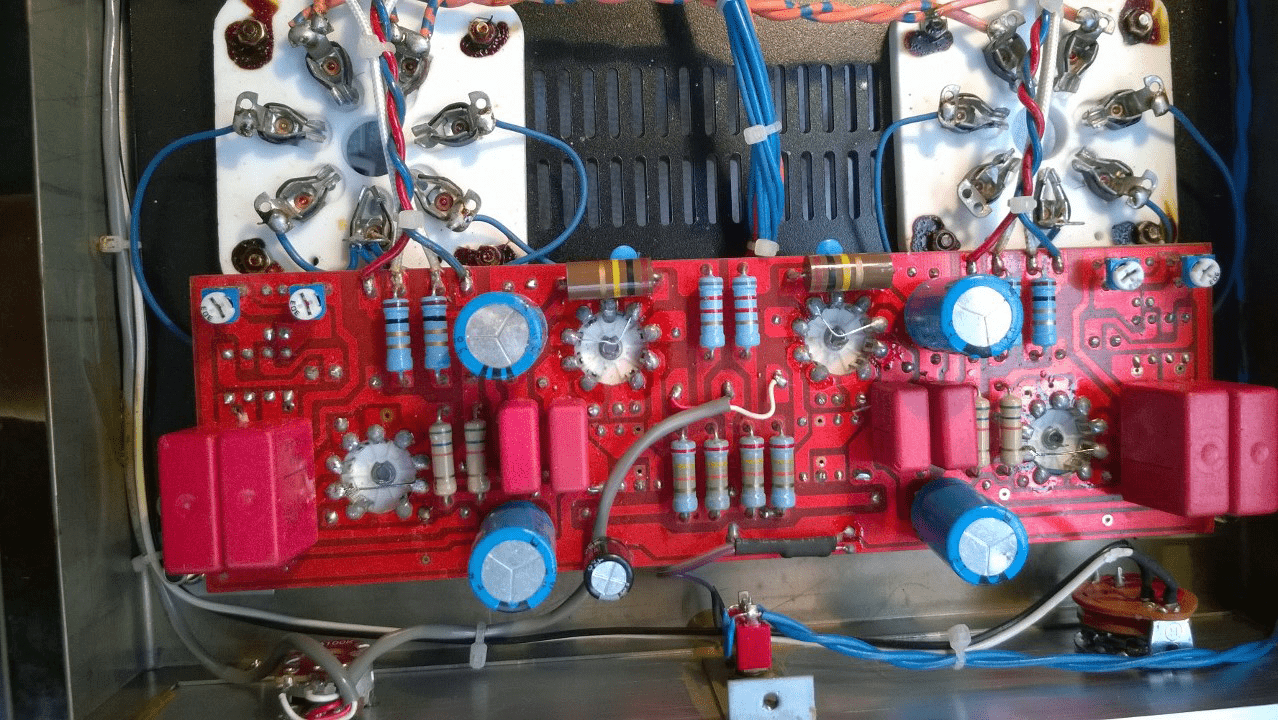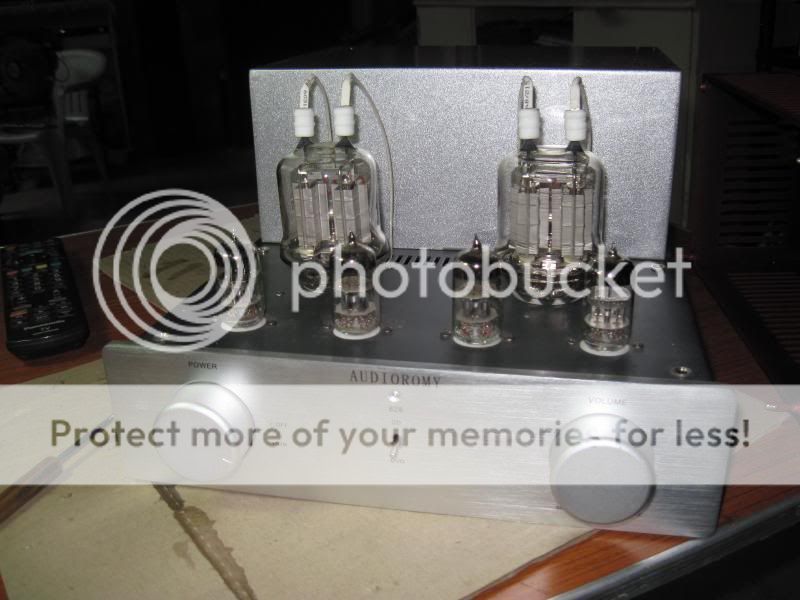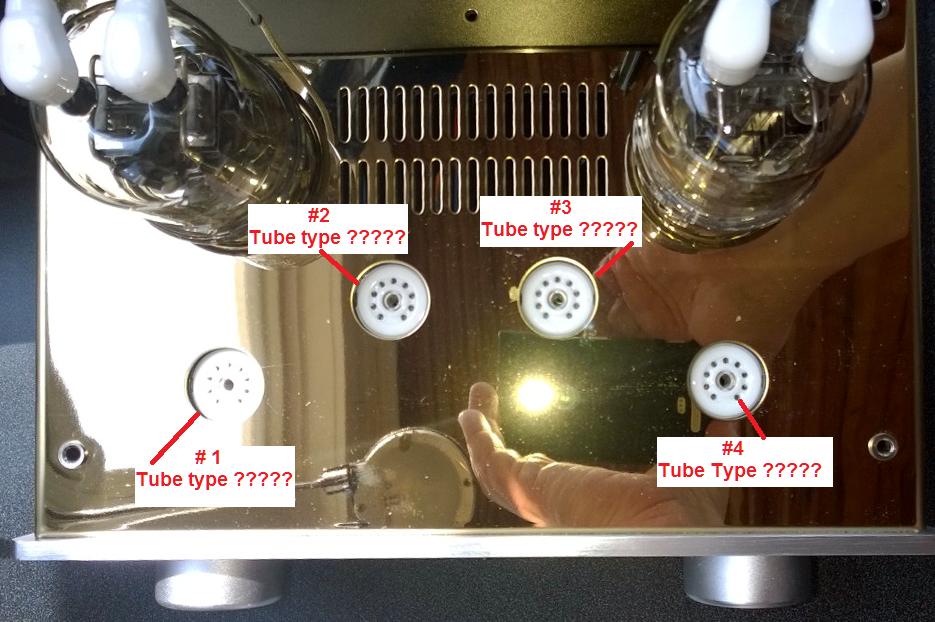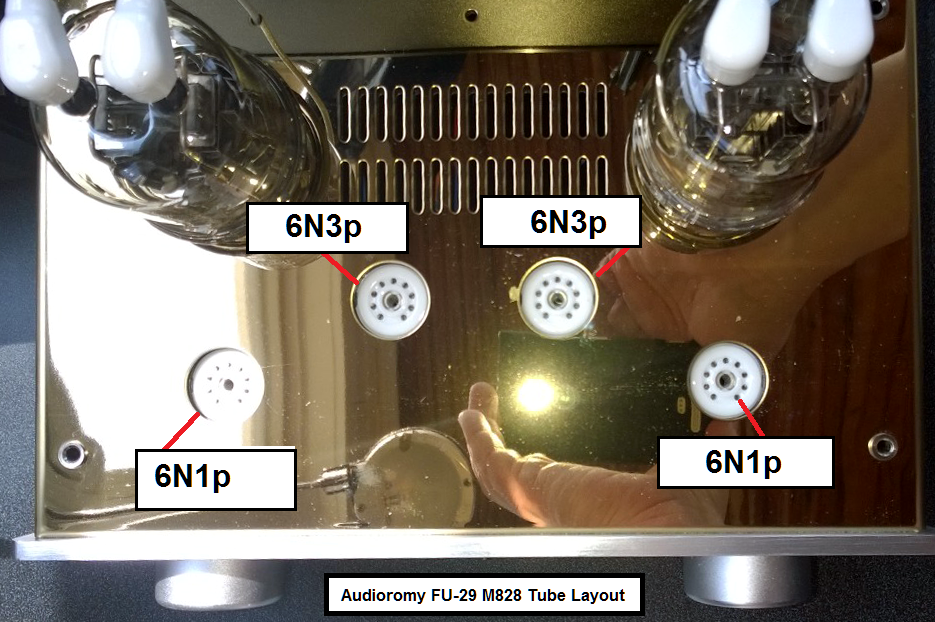Can some tell me which sockets of the Audioromy FU-29 / 828A amp are supposed to have 6n11p and which are supposed to have 6N3p?
I recently bought a used Audioromy 828A from eBay. I had one of the earlier ones and sold it, but ended up wanting another. The eBay unit arrived in fine condition, etc.
The amp I got has 5670 tubes in place of all the small dual triodes. In other words, two 5670 replacing the two 6N3p's and two 5670 replacing the two 6N11p's.
Now wait a minute- I know the 5670 and the 6N3p are equivalent- but the 6N11p? That's the same as a 6DJ8. Different transconductance, different max plate voltage, etc. Similar but not the same.
I have some 6DJ8's and want to put two of them into the amp, but since the amp is not labelled, which sockets were intended for 6N3p and which for 6N11p?
There's no website for the manufacturer and there was no manual etc included with the amp when I bought it.
============================================
I recently bought a used Audioromy 828A from eBay. I had one of the earlier ones and sold it, but ended up wanting another. The eBay unit arrived in fine condition, etc.
The amp I got has 5670 tubes in place of all the small dual triodes. In other words, two 5670 replacing the two 6N3p's and two 5670 replacing the two 6N11p's.
Now wait a minute- I know the 5670 and the 6N3p are equivalent- but the 6N11p? That's the same as a 6DJ8. Different transconductance, different max plate voltage, etc. Similar but not the same.
I have some 6DJ8's and want to put two of them into the amp, but since the amp is not labelled, which sockets were intended for 6N3p and which for 6N11p?
There's no website for the manufacturer and there was no manual etc included with the amp when I bought it.
6n3p has a different pin out than 6n1p...
There are no 6N1p tubes in this amplifier.
There are only 6N3p, 6N11p and FU29 tubes
are these set of pictures any help? https://www.flickr.com/photos/rockhound55/sets/72157628460993937/
Thanks for all the posts.
By the way I was mistaken, there are no 6N11p tubes in here, there are indeed 6N1p's in the design. I just don't know which sockets are the 6N1's and which are supposed to be 6N3's. I guess I'll have to open it up and trace it out. I just thought someone would be able to tell me which tubes go into which sockets.
By the way I was mistaken, there are no 6N11p tubes in here, there are indeed 6N1p's in the design. I just don't know which sockets are the 6N1's and which are supposed to be 6N3's. I guess I'll have to open it up and trace it out. I just thought someone would be able to tell me which tubes go into which sockets.
Actually, the above layout doesn't work. The 6N1P tube filaments don't light.
The amp came with four 5760's, placing the 5760's in all 4 sockets- all filaments lit. Maybe amp was rewired? It doesn't look to have been re-soldered anywhere.
Or is it some different version?
The PCB inside doesn't seem to be wired quite as in other photos I've seen..... look at the jumpers between pins on the tube sockets

The amp came with four 5760's, placing the 5760's in all 4 sockets- all filaments lit. Maybe amp was rewired? It doesn't look to have been re-soldered anywhere.
Or is it some different version?
The PCB inside doesn't seem to be wired quite as in other photos I've seen..... look at the jumpers between pins on the tube sockets

The earlier version used 6n1 (inside #2, #3), and 6n2 (outside #1, #4).
the newer version uses 6n23p, and 6n3 (inner/outer locations unknown to me).
Not sure how you determine earlier vs later.
Bob
Just checked amp - verified that 6n1s are the two in the middle.
also in my amp all four tubes are inline not inner two in the back.
There may be three versions - another one using 6n11s....
the newer version uses 6n23p, and 6n3 (inner/outer locations unknown to me).
Not sure how you determine earlier vs later.
Bob
Just checked amp - verified that 6n1s are the two in the middle.
also in my amp all four tubes are inline not inner two in the back.
There may be three versions - another one using 6n11s....
Last edited:
this one.....also in my amp all four tubes are inline not inner two in the back

this amp can run really hot with ambient temps of 34*C in my place..
as you can see i changed the plate caps to ceramic type,
i also converted to cathode resistor bias instead of fixed bias
using 270 ohm 5 watt/220ufd 50 volt combo...
no apparent change in sound quality and power...
The earlier version used 6n1 (inside #2, #3), and 6n2 (outside #1, #4).
the newer version uses 6n23p, and 6n3 (inner/outer locations unknown to me).
Not sure how you determine earlier vs later.
Bob
Just checked amp - verified that 6n1s are the two in the middle.
also in my amp all four tubes are inline not inner two in the back.
There may be three versions - another one using 6n11s....
Mine has four 5760's in it. Don't know if that's correct or not, that's the way it came from previous owner. Also arrived with a 3E29 (FU29) with an open filament so I have yet to listen to the amp, NOS 3E29 on order to replace that dead tube. I'll listen to it, also can run some curves for frequency response & THD, will post those.
Yes I now can confirm there is currently (May 2014) on sale a version of this amplifier with four 5670's in it. This is the one I have- HAHAHA so here I was all concerned about tube layout, when in fact all four 9-pin sockets have the same tube type in them.
-DOH! as Homer Simpson would say
-DOH! as Homer Simpson would say
there are now three e(current) Bay variations
1. 6N1/6N2 (original)
2. 5670 (four)
3. 5670 OR 2*6H3 AND 2*6N3
There are additional variables (Chinese vs Russian esp 6N1, 6H1, and P variations) and whether one of these versions substitutes for a 6922.
and whether #3 above means 6H3 = 6N3 = 5670...
Milosz: do you mean 5760 or 5670s?
In any case, glad you have it going and it sounds good to you.
Next step : tube rolling.
Bob
1. 6N1/6N2 (original)
2. 5670 (four)
3. 5670 OR 2*6H3 AND 2*6N3
There are additional variables (Chinese vs Russian esp 6N1, 6H1, and P variations) and whether one of these versions substitutes for a 6922.
and whether #3 above means 6H3 = 6N3 = 5670...
Milosz: do you mean 5760 or 5670s?
In any case, glad you have it going and it sounds good to you.
Next step : tube rolling.
Bob
I meant to say 5670. Vacuum tube dyslexia I guess.
Actually I haven't heard the thing yet- when I got it, one of the output tubes had an open filament. Likely fell apart during shipping, over time and use filaments can get brittle. I ordered a NOS replacement.
I had one of the earlier "silver top" iterations of this amp some time ago which sounded great on certain speakers, for example some little Polk RT25i's. I sold that one but now decided to try another one. For the money, these amps - with the right speakers- are really hard to beat. The one I sold is still working great, after about 3 years of daily use. Needed 2 6N1p's during that time, which are about $2 each.
(FYI this amp came with JAN GE 5670's, and the previous owner had replaced the FU29's with RCA 3E21's. One of the nice things about this amp is it uses tubes you can get without spending more on tubes than on your speakers....)
Actually I haven't heard the thing yet- when I got it, one of the output tubes had an open filament. Likely fell apart during shipping, over time and use filaments can get brittle. I ordered a NOS replacement.
I had one of the earlier "silver top" iterations of this amp some time ago which sounded great on certain speakers, for example some little Polk RT25i's. I sold that one but now decided to try another one. For the money, these amps - with the right speakers- are really hard to beat. The one I sold is still working great, after about 3 years of daily use. Needed 2 6N1p's during that time, which are about $2 each.
(FYI this amp came with JAN GE 5670's, and the previous owner had replaced the FU29's with RCA 3E21's. One of the nice things about this amp is it uses tubes you can get without spending more on tubes than on your speakers....)
- Status
- This old topic is closed. If you want to reopen this topic, contact a moderator using the "Report Post" button.
- Home
- Amplifiers
- Tubes / Valves
- Audioromy 828A / FU-29 tube layout

